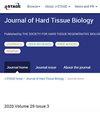MiR-148a-3p通过Wnt1/β-catenin信号通路靶向runt相关转录因子2和E-cadherin调控干细胞成骨分化和牙釉质发育
IF 0.4
4区 医学
Q4 ENGINEERING, BIOMEDICAL
引用次数: 0
摘要
我们旨在通过分别靶向runt相关转录因子2 (RUNX2)和E-cadherin来评估miR-148a-3p对干细胞成骨分化和牙釉质发育的调控作用。利用TargetScan软件预测miR-148a-3p与成骨标记基因RUNX2或E-cadherin的结合位点。检测miR-148a-3p在表皮干细胞成骨分化过程中的表达变化。转染miR-148a-3p模拟物或miR-148a-3p抑制剂后,诱导表皮干细胞向成骨分化,并测量RUNX2表达的变化。测定受表皮干细胞调控的釉质发育过程中miR-148a-3p的表达变化。脂质体介导转染miR-148a-3p模拟物或miR-148a-3p抑制剂后,诱导表皮干细胞向成釉细胞发育。分别采用甲基噻唑四氮唑法和流式细胞术检测细胞增殖和凋亡能力。RT-PCR检测miR-148a-3p的表达。Western blotting检测Wnt1、β-catenin、RUNX2、E-cadherin蛋白表达。表皮干细胞经成骨诱导培养分化为成骨细胞。在第5、12、15和30天,表皮干细胞通过上皮聚集和抑制、间充质聚集、牙本质和牙釉质分泌逐渐分化为成骨细胞。转染后,与阴性对照(NC)组比较,miR-148-3p组细胞活力显著降低(P<0.05),细胞凋亡率升高(P<0.01)。miR-148-3p抑制剂组细胞活力显著升高(P<0.05),细胞凋亡率显著降低(P<0.01)。双荧光素酶报告基因实验显示miR-148a-3p靶向Wnt1。与NC组比较,miR-148a-3p组miR-148a-3p的表达水平显著升高(P<0.001), Wnt1、β-catenin、RUNX2、E-cadherin的蛋白表达水平显著降低。与NC组比较,miR-148a-3p抑制剂组miR-148a-3p表达显著降低(P<0.05), Wnt1、β-catenin、RUNX2、E-cad herin蛋白表达水平显著升高。MiR-148a-3p通过Wnt1/β-catenin通路分别靶向RUNX2和E-cadherin,高表达调控成骨分化和牙釉质发育,在细胞分化、干细胞增殖和牙釉质发育中发挥重要作用。本文章由计算机程序翻译,如有差异,请以英文原文为准。
MiR-148a-3p Regulates Stem Cell Osteogenic Differentiation and Enamel Development by Targeting Runt-Related Transcription Factor 2 and E-cadherin via the Wnt1/β-catenin Signaling Pathway
: We aimed to evaluate the regulatory effects of miR-148a-3p on stem cell osteogenic differentiation and enamel development by targeting runt-related transcription factor 2 (RUNX2) and E-cadherin, respectively. TargetScan software was utilized to predict the binding sites between miR-148a-3p and osteogenic marker gene RUNX2 or E-cadherin. The changes in miR-148a-3p expression during osteogenic differentiation of epidermal stem cells were detected. After transfec tion with miR-148a-3p mimics or miR-148a-3p inhibitor, epidermal stem cells were induced towards osteogenic differentia tion, and the changes in RUNX2 expression were measured. The changes in miR-148a-3p expression during enamel devel opment regulated by epidermal stem cells were determined. After liposome-mediated transfection with miR-148a-3p mimics or miR-148a-3p inhibitor, epidermal stem cells were induced towards ameloblast development. Cell proliferation and apoptosis abilities were tested using methyl thiazolyl tetrazolium assay and flow cytometry, respectively. The expres sion of miR-148a-3p was detected by RT-PCR. The protein expressions of Wnt1, β-catenin, RUNX2 and E-cadherin were measured by Western blotting. Epidermal stem cells differentiated into osteoblasts through osteogenic induction culture. On 5, 12, 15 and 30 d, epidermal stem cells gradually differentiated into osteoblasts through epithelial aggregation and depres sion, mesenchymal aggregation, and dentin and enamel secretion. After transfection, compared with negative control (NC) group, the cell viability of miR-148-3p group significantly decreased (P<0.05), and the apoptosis rate increased (P<0.01). The viability of miR-148-3p inhibitor group significantly increased (P<0.05), while the apoptosis rate reduced (P<0.01). The dual-luciferase reporter assay showed that miR-148a-3p targeted Wnt1. Compared with NC group, the expression of miR-148a-3p significantly rose in miR-148a-3p group (P<0.001), and the protein expression levels of Wnt1, β-catenin, RUNX2 and E-cadherin significantly decreased. Compared with NC group, the expression of miR-148a-3p in miR-148a-3p inhibitor group significantly decreased (P<0.05), and the protein expression levels of Wnt1, β-catenin, RUNX2 and E-cad herin significantly increased. MiR-148a-3p is highly expressed in and regulates osteogenic differentiation and enamel de velopment through targeting RUNX2 and E-cadherin respectively via the Wnt1/β-catenin pathway, which plays an impor tant role in cell differentiation, stem cell proliferation and enamel development.
求助全文
通过发布文献求助,成功后即可免费获取论文全文。
去求助
来源期刊

Journal of Hard Tissue Biology
ENGINEERING, BIOMEDICAL-
CiteScore
0.90
自引率
0.00%
发文量
28
审稿时长
6-12 weeks
期刊介绍:
Information not localized
 求助内容:
求助内容: 应助结果提醒方式:
应助结果提醒方式:


